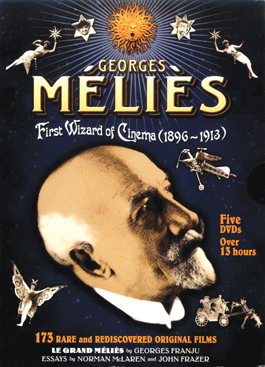home | metro silicon valley index | movies | current reviews | dvd review

Georges Méliès: First Wizard of Cinema (1896–1913)
Five discs; Flicker Alley; $89.95
By Michael S. Gant
Cinema's first special-effects genius, filmmaker Georges Méliès, learned his tricks as a magician on the stages of France's fantasy theaters. As John Frazer points out in the historical essay accompanying Flicker Alley's wonderful Méliès DVD boxed set, French theater had already developed elaborate mechanisms, "revolving stages, curtains of lights, rolling dioramas ... to effect an astonishing variety of transformations." Méliès saw early on that the infant technological marvel of the movies could take magic tricks into a whole new realm—from sleight of hand to sleight of eye. Through the simple miracle of stop-action, a woman really could disappear; with double exposures, a giant Gulliver could inhabit the screen with Lilliputian actors; with black screen and superimposition, a man could pull off his head and toss it in the air. This remarkable collection archives some 13 hours of Méliès' output, from fragments and one-minute vignettes to 15-minute mini epics, the most familiar of which is 1902's A Trip to the Moon, with its projectile space ship smacking the Man in the Moon right in the eye. Some of the shorts show their age, but for the most part the transfers are crisp and steady. While a few of the films are ostensibly what were known as "realities," i.e., re-creations of historical events (like the multipart story of the Dreyfus Affair), the vast majority are pure entertainments: filmed magic acts, slapstick hijinks (in one great gag, a prankster inserts a hose in a camera so that the seated subjects are squirted with water shooting out the lens) or complete fantasies, full of ornate painted backdrops, guys in dragon suits, zaftig chorines, bearded clowns and red-caped devils. Yes, red-caped. Not only wasn't silent film really silent, it was often not black-and-white either. Many of Méliès' movies were painstakingly hand-tinted; even individual actors sport differently colored costumes. Fire and explosions offer multiple opportunities for the spectacle of billowing red and yellow smoke. I wouldn't recommend sitting through the whole set at one sitting—the pantomiming can grow wearisome—but the films retain all of their charm and quite a bit of humor even allowing for a century's worth of movie-going sophistication. The best of them are overt dreams or hallucinations, so that the artificiality of the sets seems entirely justified. A temptress in a nightmare sits in a spider web with eight cloth tentacles flapping wildly; a giant animated bug is at least as realistic as the creature effects in The Mist; a magician cavorts with a disembodied head; a skeleton horse pulls a golden carriage across a night sky resplendent with chartreuse clouds and flaming comets. My favorite is 1903's The Kingdom of Fairies, in which a tiny ship model sinks beneath the sea. Much of the action takes place behind a real aquarium, so that goldfish swim by as if they were sea monsters. A wondrous red lobster cavorts through a multicolored grotto. Finally, the ship's crew clambers aboard a wooden whale and is spit back onto land. This exemplary contribution to film history also includes an odd 1953 documentary/biopic by French director Georges (Eyes Without a Face) Franju.
Send a letter to the editor about this story.
|
|
|
|
|
|